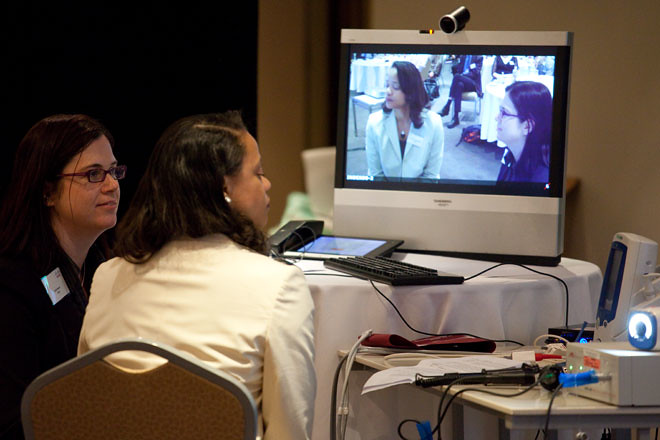Difference Between Virtual Care and Telehealth
The society we live in has become more fast-paced over the last few years, especially with our businesses, social and even healthcare needs readily available at our fingertips. Technology has a profound impact on this ever-changing scene and because our lives have now become easily accessible than before, healthcare and medical advice continue to follow on the footsteps. We have mobile applications and user friendly websites now, which allow medical providers and insurance companies to reach their patients simply via smartphones while also providing care to those in need. Today, telecommunication technologies are being used to shape the healthcare industry in unprecedented ways.
In the health sector, ICT is a cornerstone of effective and efficient services. Telehealth and telemedicine are a progression in an unstoppable transformation in healthcare. Telehealth is the integration of telecommunication systems into the practicing of protecting and promoting health. Development in Telehealth in the recent years has pushed the boundaries of traditional healthcare. Another interesting trend impacting the future of Telehealth is the emergence of “virtual healthcare” services. The term virtual healthcare is often used synonymously with Telehealth or Telemedicine, but they are two very different things and they are not to be confused with one another.

What is Virtual Healthcare?
Virtual healthcare is a component of Telehealth, which refers to the many ways healthcare providers interact with their patients remotely. It is the use of smartphone and other mobile technologies to support healthcare. Through mobile applications and user-friendly websites, healthcare providers and insurance companies can reach their patients via a more convenient medium while also providing services or care to those who may otherwise be too busy for an in-office appointment. It is more like virtual visits that take place between healthcare experts and their patients via communications technology. It gives patients the advantage of making appointments online, fast check-ins, remote monitoring, and more. Patients are becoming more engaged in healthcare through mobile visits, visual representation of test results, treatments, and have their medical needs tended to without any physical visits to the offices.

What is Telehealth?
Telehealth is a more encompassing term than virtual healthcare, which they define as the integration of ICTs into the practice of protecting and promoting health, while virtual healthcare is more like a component of Telehealth. The internet plays a key role in expanding the reach of health services to remote areas. Telehealth is the delivery of health-related services via information and communication technologies (ICTs) over both long and short distances. Telehealth is a broad term that literally means healing at a distance. It is a medium to deliver more efficient and patient-centered healthcare services to those who face physical and financial barriers to access quality healthcare support. It is one of the many areas where ICT is supporting healthcare. Technologies for delivery of Telehealth are increasingly well-established and diverse. Telehealth not only incorporates Telemedicine but also goes beyond traditional healthcare system with additional indirect benefits.
Difference between Virtual Care and Telehealth
Meaning
– Both the terms are often used synonymously with each other, but they are not the same thing. Virtual healthcare is a component of Telehealth, which refers to the many ways healthcare providers interact with their patients remotely. Virtual healthcare is more like virtual visits that take place between healthcare experts and their patients via communications technology. Telehealth, on the other hand, is a broad term that literally means healing at a distance and is defined as the integration of information and communication technologies (ICTs) into the practice of protecting and promoting health.
Purpose
– Virtual care gives patients the advantage of making appointments online, fast check-ins, remote monitoring, and more. The purpose of virtual healthcare is to provide services or care to those who may otherwise be too busy for an in-office appointment and without seeing the patient in person. Plus it gives patients access to their records and other stuff right from their smartphones or other mobile devices. The purpose of Telehealth is to provide a medium to deliver more efficient and patient-centered healthcare services to those who face physical and financial barriers to access quality healthcare support.
Delivery
– Virtual care is the use of smartphone and other mobile technologies to support healthcare through various healthcare platforms such as live audio and video chat, or instant messages. This may include remote check-ins and monitoring, diagnosis and condition checking, treatment planning, etc. There is an ever-increasing range of equipment options and delivery models from which to choose to deliver healthcare over a distance. Telehealth is based on the most updated technology solutions today including video communication, wireless and broadband IP connection, wearable medical devices, and web-based networks.
Virtual Healthcare vs. Telehealth: Comparison Chart

Summary of Virtual Healthcare vs. Telehealth
While virtual care refers to virtual visits that take place between healthcare experts and their patients via communications technology, Telehealth is a broad term that encompasses virtual healthcare services and more. Telehealth could be telephone conversation between a patient and his/her doctor, or it could be a video conference, or it could be an IVR system. Telehealth basically refers to the integration of ICTs into the practice of protecting and promoting health, whereas virtual care is just a component of Telehealth.
- Difference Between Caucus and Primary - June 18, 2024
- Difference Between PPO and POS - May 30, 2024
- Difference Between RFID and NFC - May 28, 2024
Search DifferenceBetween.net :
Leave a Response
References :
[0]Image credit: https://media.defense.gov/2020/Jan/07/2002231402/780/780/0/191218-F-ZC993-1007.JPG
[1]Image credit: https://live.staticflickr.com/6235/6307879708_5058d697d5_b.jpg
[2]Maheu, Marlene et al. E-Health, Telehealth, and Telemedicine: A Guide to Startup and Success. Hoboken, New Jersey: John Wiley & Sons, 2002. Print
[3]Wootton,Richard et al. Telehealth in the Developing World. Ottawa, Canada: IDRC, 2009. Print
[4]Gillis, G. et al. Global Telehealth 2015: Integrating Technology and Information for Better Healthcare. Amsterdam, Netherlands: IOS Press, 2015. Print
[5]Gulla, Vincenzo et al. Telehealth Networks for Hospital Services: New Methodologies. Pennsylvania, United States: IGI Global, 2013. Print
